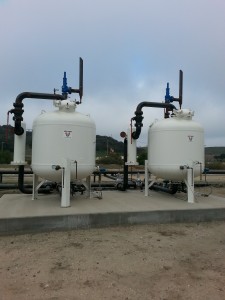Fuel Gas Conditioning – Drying and Filtering
Fuel conditioning in the natural gas industry is a broad concept that encompasses many technologies and processes. Fuel gas conditioning is the removal of contaminants from a gaseous fuel prior to combustion.The selection of a fuel conditioning process depends on the answers to a few basic questions.
- What is the contaminant in the fuel?
- What is the concentration of the contaminant in the fuel?
- What are the operating conditions associated with the fuel supply (e.g. pressure, temperature, and flow rates)?
- What is the fuel quality standard at the outlet of the conditioning system?
- What site specific conditions need to be considered, such as ambient temperature ranges, hazardous area electrical classifications, foot print restrictions, environmental constraints, and available utilities?
Common contaminants in natural gas are liquid water, water vapor, particulate matter, hydrogen sulfide, and carbon dioxide. In many areas, natural gas emerges rich in heavy hydrocarbons. While valuable and therefore not strictly contaminants, heavy hydrocarbons often render a gas stream unusable as a fuel source.
Processes for fuel gas conditioning generally fall into one of the following categories: separation, filtration, dehydration, sweetening (H2S and CO2 removal), or hydrocarbon dew point control. Within each of these process categories there can be multiple technologies that offer a solution.
Van Air Systems offers solutions for the filtration and dehydration categories. Our products remove solids, small volume liquids, and water vapor. We do not produce bulk liquid separators, sweetening plants, or get involved with processes that alter the hydrocarbon content of fuel.
To illustrate typical applications, I’ll describe two different fuel conditioning cases I’ve been involved with recently.
Case 1
A company in California is co-generating electricity and heat by burning natural gas in two C-1000 Capstone micro turbines. The fuel gas is being purchased from the local utility and is expect to be dry with a predictable heating value.
The owner of the micro turbines however is worried about particulate matter damaging the equipment. The gas utility supply pipes are aging, and pipe scale, weld debris, and dirt could migrate into the micro turbine fuel lines. To prevent solid contaminants from entering the micro turbines, Van Air Systems is supplying dual particulate removing filters. The filters are sized to match the pressure drop, flow, and fuel quality standards defined by both micro turbine manufacturer and the end-user. This application would also be a good place to use a deliquescent dryer as a guard bed to protect against off-specification, high humidity gas delivered from the utility.
Case 2
An oil producer in California injects high pressure steam into aging wells to enhance recovery. The producer generates steam by burning natural gas drawn from well casings and oil storage tanks. The fuel supply has two primary contaminants that unless removed would damage or destroy the steam generators: hydrogen-sulfide (H2S) and water vapor. To remove H2S, or sweeten the gas, the producer uses two towers packed with the scavenger Sulfa Treat. After sweeting the fuel, gas flows through a modified version of Van Air Systems’ model D54 deliquescent dryer.
Two dryers are installed in parallel for redundancy. Each dryer is filled with a deliquescent desiccant called Dry-O-Lite. This desiccant lowers the relative humidity of the fuel from 100% to about 55%. The suppressed humidity level is dry enough to both prevent damage to the steam generators and to prevent water condensation in supply piping. The producer chose the deliquescent drying process over other dehydration technologies for two reasons. One, the Van Air Systems dryers do not vent any gas and therefore do not require air permits from state regulators. Two, the dryers have no moving parts and do not require sophisticated training or expertise to operate.

